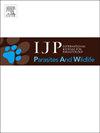线虫纲:双爪虫总科:双爪虫科)对濒危的哈特水蛇的不成比例感染
IF 2.2
3区 医学
Q3 ECOLOGY
International Journal for Parasitology-Parasites and Wildlife
Pub Date : 2025-08-28
DOI:10.1016/j.ijppaw.2025.101130
引用次数: 0
摘要
描述自然系统中的宿主-寄生虫动力学是保护宿主的优先事项。哈特水蛇(Nerodia harteri ssp.)就是这样一个物种,是德克萨斯州中北部的特有物种,受到栖息地改变、低遗传多样性和新出现的传染病的影响。在这项研究中,我们报告了三种水蛇种(N. harteri ssp.)中Eustrongylides sp.感染的新记录。在德克萨斯州中北部的布拉索斯河和科罗拉多河流域的五个人工水库中发现了红腹蛛和菱形蛛。线虫被包含在取样蛇身体中部的皮下结节中,我们量化了结节的存在作为感染流行率的代表。从7个个体中,我们从结节中提取线虫进行分子分析。对切除的线虫线粒体细胞色素c氧化酶亚基I和18S rRNA基因的系统发育分析证实了Eustrongylides sp.的身份,并将我们的样本确定为一个独立的分支,该分支与先前从亚洲加入的谱系不同。危险的N. harteri比同域水蛇有更高的感染风险。蛇在格兰伯里湖更频繁地受到感染,那里是黑僵菌的大本营。虽然观察到的感染率很低,但真圆内酯类感染可以在中间宿主中引起严重的病理反应,我们的研究结果强调了对哈特尼布氏线虫适应性影响的评估和进一步的寄生虫学监测的必要性,以便为管理提供信息。本文章由计算机程序翻译,如有差异,请以英文原文为准。

Disproportionate infection by Eustrongylides sp. (Nematoda: Dioctophymatoidea: Dioctophymatidae) in the imperiled Harter's watersnake, Nerodia harteri
Describing host-parasite dynamics in natural systems is a priority for hosts of conservation concern. Harter's watersnake (Nerodia harteri ssp.) is one such species, endemic to north-central Texas and impacted by habitat alteration, low genetic diversity, and emerging infectious diseases. In this study, we report new records of Eustrongylides sp. infections in three watersnake species (N. harteri ssp., N. erythrogaster, and N. rhombifer) from five artificial reservoirs in the Brazos and Colorado River watersheds in north-central Texas. Nematodes were contained within subcutaneous nodules on the midbody of sampled snakes, and we quantified nodule presence as a proxy for infection prevalence. From seven individuals, we extracted nematodes from nodules for molecular analysis. Phylogenetic analyses on the mitochondrial cytochrome c oxidase subunit I and 18S rRNA genes of excised nematodes confirmed the identity as Eustrongylides sp. and resolved our samples into a single well supported clade divergent to previously accessioned lineages from Asia. The imperiled N. harteri had a higher risk of infection than sympatric watersnakes. Snakes were more frequently infected in Lake Granbury, a stronghold for N. harteri. Though observed infection rates were low, Eustrongylides sp. infections can induce severe pathologic responses in intermediate hosts, and our findings highlight the need for assessments of fitness implications and further parasitological surveillance in N. harteri to inform management.
求助全文
通过发布文献求助,成功后即可免费获取论文全文。
去求助
来源期刊

International Journal for Parasitology-Parasites and Wildlife
Medicine-Infectious Diseases
CiteScore
3.80
自引率
5.60%
发文量
113
审稿时长
45 days
期刊介绍:
The International Journal for Parasitology: Parasites and Wildlife (IJP-PAW) publishes the results of original research on parasites of all wildlife, invertebrate and vertebrate. This includes free-ranging, wild populations, as well as captive wildlife, semi-domesticated species (e.g. reindeer) and farmed populations of recently domesticated or wild-captured species (e.g. cultured fishes). Articles on all aspects of wildlife parasitology are welcomed including taxonomy, biodiversity and distribution, ecology and epidemiology, population biology and host-parasite relationships. The impact of parasites on the health and conservation of wildlife is seen as an important area covered by the journal especially the potential role of environmental factors, for example climate. Also important to the journal is ''one health'' and the nature of interactions between wildlife, people and domestic animals, including disease emergence and zoonoses.
 求助内容:
求助内容: 应助结果提醒方式:
应助结果提醒方式:


